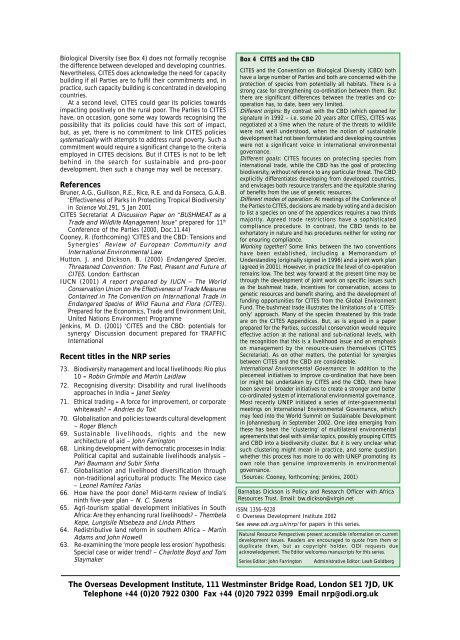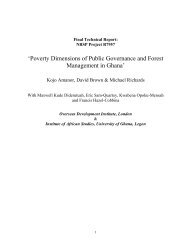International conservation treaties, poverty and development: The ...
International conservation treaties, poverty and development: The ...
International conservation treaties, poverty and development: The ...
Create successful ePaper yourself
Turn your PDF publications into a flip-book with our unique Google optimized e-Paper software.
Biological Diversity (see Box 4) does not formally recognise<br />
the difference between developed <strong>and</strong> developing countries.<br />
Nevertheless, CITES does acknowledge the need for capacity<br />
building if all Parties are to fulfil their commitments <strong>and</strong>, in<br />
practice, such capacity building is concentrated in developing<br />
countries.<br />
At a second level, CITES could gear its policies towards<br />
impacting positively on the rural poor. <strong>The</strong> Parties to CITES<br />
have, on occasion, gone some way towards recognising the<br />
possibility that its policies could have this sort of impact,<br />
but, as yet, there is no commitment to link CITES policies<br />
systematically with attempts to address rural <strong>poverty</strong>. Such a<br />
commitment would require a significant change to the criteria<br />
employed in CITES decisions. But if CITES is not to be left<br />
behind in the search for sustainable <strong>and</strong> pro-poor<br />
<strong>development</strong>, then such a change may well be necessary.<br />
References<br />
Bruner, A.G., Gullison, R.E., Rice, R.E. <strong>and</strong> da Fonseca, G.A.B.<br />
‘Effectiveness of Parks in Protecting Tropical Biodiversity’<br />
in Science Vol.291, 5 Jan 2001<br />
CITES Secretariat A Discussion Paper on “BUSHMEAT as a<br />
Trade <strong>and</strong> Wildlife Management Issue” prepared for 11 th<br />
Conference of the Parties (2000, Doc.11.44)<br />
Cooney, R. (forthcoming) ‘CITES <strong>and</strong> the CBD: Tensions <strong>and</strong><br />
Synergies’ Review of European Community <strong>and</strong><br />
<strong>International</strong> Environmental Law<br />
Hutton, J. <strong>and</strong> Dickson, B. (2000) Endangered Species,<br />
Threatened Convention: <strong>The</strong> Past, Present <strong>and</strong> Future of<br />
CITES. London: Earthscan<br />
IUCN (2001) A report prepared by IUCN – <strong>The</strong> World<br />
Conservation Union on the Effectiveness of Trade Measures<br />
Contained in <strong>The</strong> Convention on <strong>International</strong> Trade in<br />
Endangered Species of Wild Fauna <strong>and</strong> Flora (CITES).<br />
Prepared for the Economics, Trade <strong>and</strong> Environment Unit,<br />
United Nations Environment Programme<br />
Jenkins, M. D. (2001) ‘CITES <strong>and</strong> the CBD: potentials for<br />
synergy’ Discussion document prepared for TRAFFIC<br />
<strong>International</strong><br />
Recent titles in the NRP series<br />
73. Biodiversity management <strong>and</strong> local livelihoods: Rio plus<br />
10 – Robin Grimble <strong>and</strong> Martin Laidlaw<br />
72. Recognising diversity: Disability <strong>and</strong> rural livelihoods<br />
approaches in India – Janet Seeley<br />
71. Ethical trading – A force for improvement, or corporate<br />
whitewash? – Andries du Toit<br />
70. Globalisation <strong>and</strong> policies towards cultural <strong>development</strong><br />
– Roger Blench<br />
69. Sustainable livelihoods, rights <strong>and</strong> the new<br />
architecture of aid – John Farrington<br />
68. Linking <strong>development</strong> with democratic processes in India:<br />
Political capital <strong>and</strong> sustainable livelihoods analysis –<br />
Pari Baumann <strong>and</strong> Subir Sinha<br />
67. Globalisation <strong>and</strong> livelihood diversification through<br />
non-traditional agricultural products: <strong>The</strong> Mexico case<br />
– Leonel Ramírez Farías<br />
66. How have the poor done? Mid-term review of India’s<br />
ninth five-year plan – N. C. Saxena<br />
65. Agri-tourism spatial <strong>development</strong> initiatives in South<br />
Africa: Are they enhancing rural livelihoods? – <strong>The</strong>mbela<br />
Kepe, Lungisile Ntsebeza <strong>and</strong> Linda Pithers<br />
64. Redistributive l<strong>and</strong> reform in southern Africa – Martin<br />
Adams <strong>and</strong> John Howell<br />
63. Re-examining the ‘more people less erosion’ hypothesis:<br />
Special case or wider trend? – Charlotte Boyd <strong>and</strong> Tom<br />
Slaymaker<br />
Box 4 CITES <strong>and</strong> the CBD<br />
CITES <strong>and</strong> the Convention on Biological Diversity (CBD) both<br />
have a large number of Parties <strong>and</strong> both are concerned with the<br />
protection of species from potentially all habitats. <strong>The</strong>re is a<br />
strong case for strengthening co-ordination between them. But<br />
there are significant differences between the <strong>treaties</strong> <strong>and</strong> cooperation<br />
has, to date, been very limited.<br />
Different origins: By contrast with the CBD (which opened for<br />
signature in 1992 – i.e. some 20 years after CITES), CITES was<br />
negotiated at a time when the nature of the threats to wildlife<br />
were not well understood, when the notion of sustainable<br />
<strong>development</strong> had not been formulated <strong>and</strong> developing countries<br />
were not a significant voice in international environmental<br />
governance.<br />
Different goals: CITES focuses on protecting species from<br />
international trade, while the CBD has the goal of protecting<br />
biodiversity, without reference to any particular threat. <strong>The</strong> CBD<br />
explicitly differentiates developing from developed countries,<br />
<strong>and</strong> envisages both resource transfers <strong>and</strong> the equitable sharing<br />
of benefits from the use of genetic resources.<br />
Different modes of operation: At meetings of the Conference of<br />
the Parties to CITES, decisions are made by voting <strong>and</strong> a decision<br />
to list a species on one of the appendices requires a two thirds<br />
majority. Agreed trade restrictions have a sophisticated<br />
compliance procedure. In contrast, the CBD tends to be<br />
exhortatory in nature <strong>and</strong> has procedures neither for voting nor<br />
for ensuring compliance.<br />
Working together? Some links between the two conventions<br />
have been established, including a Memor<strong>and</strong>um of<br />
Underst<strong>and</strong>ing (originally signed in 1996) <strong>and</strong> a joint work plan<br />
(agreed in 2001). However, in practice the level of co-operation<br />
remains low. <strong>The</strong> best way forward at the present time may be<br />
through the <strong>development</strong> of joint work on specific issues such<br />
as the bushmeat trade, incentives for <strong>conservation</strong>, access to<br />
genetic resources <strong>and</strong> benefit sharing, <strong>and</strong> the <strong>development</strong> of<br />
funding opportunities for CITES from the Global Environment<br />
Fund. <strong>The</strong> bushmeat trade illustrates the limitations of a ‘CITESonly’<br />
approach. Many of the species threatened by this trade<br />
are on the CITES Appendices. But, as is argued in a paper<br />
prepared for the Parties, successful <strong>conservation</strong> would require<br />
effective action at the national <strong>and</strong> sub-national levels, with<br />
the recognition that this is a livelihood issue <strong>and</strong> an emphasis<br />
on management by the resource-users themselves (CITES<br />
Secretariat). As on other matters, the potential for synergies<br />
between CITES <strong>and</strong> the CBD are considerable.<br />
<strong>International</strong> Environmental Governance: In addition to the<br />
piecemeal initiatives to improve co-ordination that have been<br />
(or might be) undertaken by CITES <strong>and</strong> the CBD, there have<br />
been several broader initiatives to create a stronger <strong>and</strong> better<br />
co-ordinated system of international environmental governance.<br />
Most recently UNEP initiated a series of inter-governmental<br />
meetings on <strong>International</strong> Environmental Governance, which<br />
may feed into the World Summit on Sustainable Development<br />
in Johannesburg in September 2002. One idea emerging from<br />
these has been the ‘clustering’ of multilateral environmental<br />
agreements that deal with similar topics, possibly grouping CITES<br />
<strong>and</strong> CBD into a biodiversity cluster. But it is very unclear what<br />
such clustering might mean in practice, <strong>and</strong> some question<br />
whether this process has more to do with UNEP promoting its<br />
own role than genuine improvements in environmental<br />
governance.<br />
(Sources: Cooney, forthcoming; Jenkins, 2001)<br />
Barnabas Dickson is Policy <strong>and</strong> Research Officer with Africa<br />
Resources Trust. Email: bw.dickson@virgin.net<br />
ISSN: 1356–9228<br />
© Overseas Development Institute 2002<br />
See www.odi.org.uk/nrp/ for papers in this series.<br />
Natural Resource Perspectives present accessible information on current<br />
<strong>development</strong> issues. Readers are encouraged to quote from them or<br />
duplicate them, but as copyright holder, ODI requests due<br />
acknowledgement. <strong>The</strong> Editor welcomes manuscripts for this series.<br />
Series Editor: John Farrington Administrative Editor: Leah Goldberg<br />
<strong>The</strong> Overseas Development Institute, 111 Westminster Bridge Road, London SE1 7JD, UK<br />
Telephone +44 (0)20 7922 0300 Fax +44 (0)20 7922 0399 Email nrp@odi.org.uk
















